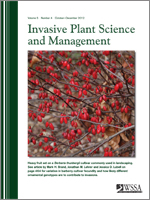Greenhouse studies were conducted on two southern Illinois star-of-Bethlehem populations to determine the influence of chilling and bulb chipping on plant growth and reproduction. Chilling was not required for leaf emergence of dormant bulbs, but an increase to 10 wk of chilling proportionally delayed leaf emergence by 41 and 42 d for the Murphysboro and the Marion populations, respectively. Bulb chipping did reduce plant height when compared to plants from nonchipped bulbs. Also, chipped bulbs produced a greater number of small daughter bulbs compared to nonchipped bulbs; however, total bulblet production was variable and dependent on population, mother bulb size, and chipping treatment. Overall, bulb chipping did not have any negative influence on star-of-Bethlehem and might promote increased daughter bulblet production. Therefore, field operations, such as tillage, that cut and chip bulbs might actually accentuate both the spread and density of star-of-Bethlehem infestations.
Nomenclature: Star-of-Bethlehem, Ornithogalum umbellatum L. OTGUM
Management Implications: Star-of-Bethlehem is a persistent and aggressive invader of pastures and cropland. Although its movement to new fields is slow, once established in a field, star-of-Bethlehem populations can increase rapidly in area and density. Nonuniform leaf emergence in the spring makes foliar herbicide applications very difficult to plan while ensuring all plants have leaves emerged so no plants escape the foliar treatment. Additionally, very few herbicide options have proven effective on this pest. The results from this research show that star-of-Bethlehem does not require chilling to emerge; however, chilling can delay plant growth and leaf emergence. Therefore, the winter climate and exposure of a field might greatly determine star-of-Bethlehem leaf emergence, and subsequently, the timing of herbicide applications. Tillage also has been used as a control measure; however, due to Star-of-Bethlehem's perennial growth habit and propagation through bulb formation, it is probable that tillage could actually increase plant densities rather than decrease them. Greenhouse experiments simulating potential damage to star of-Bethlehem bulbs by tillage confirm that bulb chipping caused by tillage can increase production of bulblets, therefore enhancing the spread of this weed. From these findings, grower practices and future research should be focused on evaluating effective herbicide options and applications timings for management of star-of-Bethlehem.





